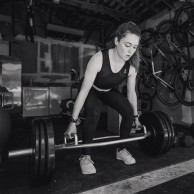The importance of Strength in cycling "There are too many cyclists who only ride their bikes"
"Professional footballers train with weights on the field, swimmers practice with paddles in their hands, and athletes in other sports do different exercises to improve their performance by increasing muscle memory. Too many cyclists just ride their bikes". Mike Kolin.
For several years there has been a debate about whether strength training is necessary for cyclists, whether it is really useful or not to improve their performance during the season.

Is it necessary for cyclists to do strength training?
The answer is easy, we have more than 660 muscles in our body, and their strength and flexibility contribute to our performance as they make up between 40 and 55% of our body mass. Therefore, we should be able to develop all their capabilities to the fullest.
RECOMENDADO

Black Friday 2025 cycling bargains: save on Garmin, POC, Maxxis and more

Black Friday Garmin 2025: the ultimate guide to choosing your GPS at the best price

How to wash your cycling clothes? 10 keys to make them always look new

Cycling can help you fight the effects of the time switch

Important keys to make your training work

Easy to apply tips for riding faster
We will consider strength as a tool to overcome the limiting factor of a cyclist when faced with the difficulty of applying more force to the pedal and for a longer period of time, with which we will improve in different phases of his competitions: sprints, climbs, time trials...
With strength work there are scientific studies that show a clear improvement in the relative power (w/kg) and absolute power of the cyclist, also with an improvement in their aerobic capacity (VO2max).
Given the evidence of strength improvement in cyclists after a period of work, there are some who do not believe in this preparation in the gym. Their consideration is that they may "gain" body weight due to the gym work, which may be normal although in the face of specific maximum strength work the gain in body weight is very low (1 to 2 kg), which if we use the formula of relative power (watts of power generated divided by body weight) we can check whether or not it has been worth doing the gym work. The vast majority of cases will be positive, as the athlete may gain weight but the power gain is much higher, giving an improvement in this performance factor which is decisive in many phases of the competition.

And the question that follows is: What factors should I take into account when developing a strength programme and how should I go about it?
First and foremost, we must individualise the strength work with the athlete taking into account these considerations:
- Level of experience: if it is your first year training strength (we should start in post-adolescent phases) you will not work in the same way on maximal strength as an athlete who has been working in the gym for 5 years. You should work with medium or light loads compared to the more experienced athlete, who will work with medium - high loads.
- Periodisation: strength work is antagonistic to endurance work in terms of the same volume and intensity, so it is important to plan the period of the year in which it should be carried out, the intensity, volume, frequency per week...
- Warm-up and relaxation: ALWAYS do a warm-up of about 10 minutes of aerobic activity beforehand. Also, at the end of a strength session, get on the exercise bike with very little resistance at a high cadence to fully recover and relax.
- Progressive work: you must be careful when moving to a new phase of strength training, especially when starting with maximal strength.
- Order of exercises: the work is organised in different phases with different objectives and within these phases there are work sessions with an order in their exercises. We often think that this order is not important, on the contrary, the aim is to progress in them correctly and gradually, in order to guarantee optimal recovery.
- Work intensity: the intensity of the strength work is measured as a percentage of 1 RM, which is the maximum load to be moved by the athlete in a single repetition. It can also be measured in terms of perceived exertion (RPE) or by speed of execution and loss of speed in each repetition, but it is very rare to find gyms with a linear encoder to measure this speed. Therefore, we will work most of the time according to the percentage of this 1 RM, depending on the phase we are in.
- Recovery intervals: as important is the work to be done as the recovery, giving a recovery time between exercises that are important for the muscle to eliminate accumulated lactate and other metabolites produced by the exercise, the HR to drop and replenish energy reserves.

With these considerations in mind, we can determine different phases of strength work, which will be summarised below in an orderly way in the periodisation of strength:
- Anatomical adaptation: this is the first phase of work, the aim is to prepare the muscles and tendons for the greater load in the following phases. There are more exercises than in other phases because we want to improve the overall strength of the body. We also train less on the bike and therefore have more time to work with weights. We work 2-3 sessions per week, 2 to 5 sets of 20 to 30 repetitions. Recovery between sets of 1' to 1' 30''.
- Maximal strength: this is a tough phase of strength training, in which there is a risk of injury. You should select the loads conservatively at the beginning of the phases, gradually increasing the workloads. This phase is worked 2 to 3 times per week, with 3 to 4 sets of 8 repetitions maximum, reducing or increasing the number of repetitions. Recovery between sets is 2 to 4'.
- Maintenance of strength or resistance to strength: this is a period that should be maintained throughout most of the year, we continue to visit the gym, but for maintenance work, where we can work 2 to 3 series with 5-8 repetitions at a medium-high load to maintain the adaptations acquired during the previous work periods. There will be 1 or 2 sessions per week. It is also preceded by more specific work on the bike where you can incorporate exercises with the bike at low cadences, sitting on slopes in addition to exercises in the gym, because although the work with the bike may seem sufficient, we can also continue to lose core strength.
In conclusion, strength work is an indispensable work for the improvement of the cyclist's performance where he/she can obtain his/her maximum performance during the season. A gain in maximum power is equivalent to an improvement in the force applied to a pedal and therefore to a transmission, giving it greater speed and at the same time, better effectiveness.
With strength work we also improve our resistance to the loss of strength or, in other words, during a prolonged effort we must be able to apply as much strength as possible for as long as possible or, when the demands of the competition require it, to have power peaks at the end of a race or route. We must also understand strength work as a preventive element for injuries, something that sometimes we do not give so much importance to.